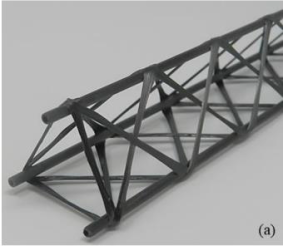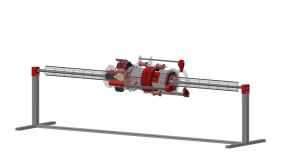PhD projects: 2017 cohort
- Investigating the effects of manufacturing processes on the structural, thermal and crystallisation properties of HDPE and UHMWPE composite materials with polypropylene fibre reinforcement
- Investigation of the high-temperature mechanical behaviour of oxide-oxide ceramic-matrix composites
- Micro-scale analysis of progressive damage in ceramic matrix composites
- Bioinspired nonlinear structures: elastic instabilities and sound production
- A design approach for super efficient Wrapped Tow Reinforced Hierarchical Space Frames
- Characterisation and understanding of viscoelastic leading edge protection solutions used on offshore wind turbines
- Functional MOF/ polymer nanocomposites with improved processability for sustainable energy applications
- Advanced numerical methods for modelling impact in composite materials
- Plasma surface modification of UHMWPE fibres and its effects on adhesion and wettability
- Development of novel transportation shells for use in high volume composite part manufacture: the clamshell concept
Investigating the effects of manufacturing processes on the structural, thermal and crystallisation properties of HDPE and UHMWPE composite materials with polypropylene fibre reinforcement
 Student: Eileen Atieno
Student: Eileen Atieno
Supervisors: Steve Eichhorn, Fabrizio Scarpa and LaShanda Korley (University of Delaware)
Nanofibres offer a route to structure composites to provide strength, stiffness and toughening. Many approaches have been developed for this purpose, one of the most popular in research terms being electrospinning. Electrospinning offers an effective and fast method in nanofibre production however, difficulties in production of consistent fibres with uncertain molecular orientation of the chains limits use of this method. This project aims to manufacture and test bi-layer coextruded fibres with different polymers in the core and the sheath and use hot compaction for selective melting of the sheath. The objectives include fabrication of bi-continuous phase composites using single and dual component polymers, assessment of orientation of the polymer fibres post fabrication using diffraction and spectroscopic techniques and mechanical testing of the composites. Ultimately, addition of other functionalities would aid in assessing how the manufactured materials could be used in a tissue engineering construct, particularly growth of bone cells on the materials. This novel approach in use of layered fibres alongside hot compaction is expected to provide biocompatibility for a range of hard/soft tissue applications.
Investigation of the high-temperature mechanical behaviour of oxide-oxide ceramic-matrix composites
 Student: Joachim Paul Forna Kreutzer
Student: Joachim Paul Forna Kreutzer
Supervisors: Giuliano Allegri, Dong Liu, Martin Kuball
The continuous push for improved strength-to-weight ratios and high temperature performance retention has been an important factor in the development of novel materials for aerospace applications. Ceramic matrix composites (CMC), with their vastly superior toughness compared to monolithic ceramics, offer great potential in this regard. Lower specific densities than currently employed alloys and metals along with significant high-temperature retention of mechanical properties mark the two main criteria that CMCs fulfil towards their prospective implementation in aerospace applications. For example, the employment of CMCs in gas turbines would lead to reductions in both component mass and cooling requirements and consequently to lower fuel consumption and exhaust gas emissions. Additionally, the suitability of CMCs has been investigated for use nuclear reactors and in space vehicle fuselage for heat protection during the re-entry phase.
To the present day, silicon carbide composites have attracted the most attention from researchers in the field of CMCs. The main concerns in this case are oxidation and environmental effects even at an intermediate temperature regime (500-800°C). Embrittlement of the composite can lead to onset of strength degradation at temperatures as low as 400°C thus limiting their use in long-term, oxidising environments. A second major class of CMCs consists of oxide composites. The two classes have somewhat complementary properties, thus determining their suitability for different purposes. Contrary to SiC composites, oxide CMCs exhibit superior oxidation stability, but offer decreased mechanical performance especially in terms of creep behaviour and strengths
Toughness in virtually all CMC systems is achieved through a crack deflection mechanism at the fibre/matrix interface whereby a propagating matrix crack does not lead to the immediate in-plane failure of the fibre but is partially deflected along the latter. The primary matrix crack eventually continues its path around the fibre albeit with a reduced stress intensity factor and bridged by the unbroken fibre. Further loading of the composite will result in the failure of the fibre at a certain distance away from the matrix crack, followed by fibre pull-out. To attain crack deflection capabilities in CMCs, two main approaches have been employed: (i) weak interphases (fibre coatings); (ii) weak (porous) matrices. It should be noted, however, that the exact mechanism for crack deflection and crack propagation is not known especially in the case of porous matrices.
Furthermore, due to the high processing temperatures and thermal expansion coefficient mismatches between the constituents, substantial residual stresses can be present in the CMCs and can have marked influences on the properties of the system, A further consequence of the high processing temperatures is the formation of cracks which in turn have a major impact on the behaviour of the systems, possibly by facilitating crack propagation and weakening the composite.
Aims and novelty of the research:
- Establish a detailed link between microstructure, distribution of residual stresses, the damage mechanism and the failure mode of multiple oxide CMCs. Initially this will be done at room temperature, followed by analogous analyses under severe conditions that are relevant for service. The techniques that will be employed consist but are not limited to: scanning electron microscopy X-ray computed microtomography, Raman microspectroscopy, 4-point bending with in situ observation of digital image correlation and tomography.
- Using the experimental information, generate a numerical model of the crack behaviour in CMCs.
- Modify present processing methodologies in order to improve the performance of the CMCs.
Micro-scale analysis of progressive damage in ceramic matrix composites
 Student: Riccardo Manno
Student: Riccardo Manno
Supervisors: Giuliano Allegri, Stephen Hallet, Antonio Merlo and Stephen Pattison (Rolls-Royce)
Ceramic Matrix Composites (CMCs) offer a unique combination of low mass density with outstanding mechanical performance at high-temperature compared to super-alloys. For this reason, CMCs are considered key enablers for next-generation aerospace technology, in particular regarding propulsion. The critical issue to face when dealing with the design of CMCs load-bearing elements is the ability to predict the in-service mechanical properties. This requires complex, multi-scale approaches from single fibre level up to full-scale laminates.
Understanding the mechanical behaviour of CMCs involves both experimental characterisation and modelling at multiple length scales, which require special laboratory techniques and dedicated numerical modelling tools. The purpose of this project is to investigate the damage behaviour of CMCs at the micro-scale. This level of analysis entails Representative Volume Elements (RVEs) located within single fibrous tows. At this scale, the damage appears in diffuse complex patterns of microcracks, usually originating from defects, such as voids. Furthermore, the presence of a thin layer of coating (usually Pyrocarbon or Boron Nitride) on the ceramic fibres has a crucial effect on the constitutive behaviour. Indeed, whilst monolithic ceramic materials have a brittle response, CMCs are characterised by a quasi-ductile response.
This PhD will focus primarily on the characterisation of the main damage mechanism which drives the failure in CMCs utilising the adoption of periodic unit-cell finite element models. As previously explained, the possible mechanisms could involve the matrix microcracking, the decohesion of the interfaces or even the oxidation of the elementary components due to the in-service environmental conditions. Hence, the formulation of a novel Continuum Damage Model (CDM) for the matrix micro-scale cracking, associated with a cohesive formulation for fibre debonding and pull-out mechanism, will be one of the principal tasks of this project. Furthermore, the possibility of embedding oxidative effects within the cohesive and CDM damage models will be explored. Along with numerical methods, analytical techniques will be exploited as well, where the level of accuracy is adequate for the task. Micro-scale models will then inform meso-scale FE models in order to achieve a sufficient level of accuracy in predicting the mechanical responses. Hence, the definition of a detailed micro-scale level behaviour will be crucial for the rigorous definition of the structural scale mechanical properties.
This work is also directly supported by Rolls-Royce plc. The industrial supporter will provide experimental data regarding CMC mechanical performance as well as the information related to the micro-scale architecture to inform the analytical and finite element models.
Bioinspired nonlinear structures: elastic instabilities and sound production
 Student: Hernaldo Mendoza Nava
Student: Hernaldo Mendoza Nava
Supervisors: Rainer Groh, Marc Holderied and Alberto Pirrera
It has recently been posited that Yponomeutidae moths have evolved sound-producing mechanisms as a means of defending against predators. For example, this can be achieved by distracting or even jamming the echolocation signals of bats. Significant levels of sound production in the ultrasonic spectrum have been recorded in Yponomeutidae moths, but the source of this sound is currently unexplained. A peculiarity of Yponomeutidae moths is that they feature tymbal-like translucent patches without scales in the hind wings. The tymbal is not actuated by muscles, as is the case for tiger moths, but rather through aeroelastic forces while beating its wings. The previous research carried out during the six-month XP project has elucidated that snapping of the ridges could indeed produce amplified oscillations in a connected clear patch of the wing. These oscillations are large enough to produce the sound pressure levels recorded at the School of Biological Sciences. This conclusion was based on a simple 1D model coupled with closed-form structural-acoustic calculations. The main objective is to assess the coupling between structural vibrations and acoustics on a model extended to two dimensions, taking into account the materials properties of the composite membrane (Chitin reinforced protein matrix) to provide further insight into the mechanisms at play during sound production. A secondary objective is to take inspiration from nature and develop an engineering prototype, i.e. a large-scale composite replica of the ribbed tymbal to demonstrate scale invariance. The biomechanics understanding of the tymbal can inspire the design of stealth systems, passive sensors or actuators for purposes such as structural health monitoring in composite structures, and/or active sensors with low frequency actuation and ultrasonic response. The novelty of this project is to approach the biomechanical function of a recently studied biological system for its implementation in engineering applications.
A design approach for super efficient Wrapped Tow Reinforced Hierarchical Space Frames
 Student: Francecsogiuseppe Morabito
Student: Francecsogiuseppe Morabito
Supervisors: Ben Woods, Terence Macquart, Mark Shenk, Alberto Pirrera
Recent developments in ultra-efficient composite beam-like truss structures (see Figure 1), have shown very high levels of achievable structural efficiency through the combination of truss geometries, composite material properties, and a low cost, scalable manufacturing process. Filament winding tends to cope better in terms of machine simplicity compared to other manufacturing techniques such as braiding or pultrusion; on the other hand, filament winding tends to fail when faced with long slender beams and high throughput production. Therefore, the aim of this research is to move away from batch manufacturing methods and develop a continuous technique such as pultrusion and braiding, but with less complexity involved as in the case of filament winding. To achieve such kind of manufacturing process, a new prototype concept is currently under development here at University of Bristol (TrussBot see Figure 2). The prototype is capable of winding multiple tows in opposite directions to achieve a fully wound truss structure in one passage, avoiding the need of a classical alternate reciprocation motion of conventional machines. This innovative methodology, due to its capability of manufacturing objects with a much longer span than its construction, will allow a high throughput continuous production of standardized truss beams for both pre-fabricated and in-situ production of trusses.


Figure 1: WrapTor Truss beam. Figure 2: Isometric view of the TrussBot concept prototype.
Characterisation and understanding of viscoelastic leading edge protection solutions used on offshore wind turbines
 Student: Imad Ouachan
Student: Imad Ouachan
Supervisors: Carwyn Ward, Ian Hamerton, Kirsten Dyer (ORE Catapult)
Offshore wind turbine blades are expected to remain in operation with minimal maintenance for a service life of 25 years. However, it is estimated that up to £1.3 million is spent on each turbine during its lifetime due to leading edge erosion (LEE) from the impact of rain droplets with current coating systems. Erosion can be reduced by limiting blade tip speeds (currently approx. 100 m/s), but with reduced noise restrictions offshore, the current trend is for increasing the blade length and tip speeds to maximise the potential of wind turbines in an already competitive energy market.
LEE can be caused by rain, hail, sea spray, and other particulate debris such as sand, dependent on the operating environment. For offshore wind turbines, liquid droplet impingement results in significant blade erosion, which is detrimental to aerodynamic efficiency and, as a result, decreased energy capture. Current solutions are not suitable and fail prematurely in their lifecycle at a cost to the wind industry as failure mechanisms for rain erosion are not well understood. This is thought to be due to the elastic and viscoelastic polymer properties at the resulting high strain rates (106 - 109 Hz) of raindrop impacts.
Current rain erosion lifetime prediction models work generally well with homogeneous materials which undergo brittle failure. However, for highly elastic and viscoelastic materials whose failure is not understood, and whose properties currently cannot be measured, models cannot be improved to accurately predict the lifetime performance. They are therefore not accurate with the more highly viscoelastic materials which are currently being developed at industrial level. Therefore, a measurement technique needs to be developed which can measure, and be used to develop understanding of, the viscoelastic response of the coatings in both the accelerated rain erosion test and real wind turbine environment. The latter have implicit differences between work hardening, relaxation and recovery. A potential solution being explored is the use of ultrasonics as previous studies have shown that the speed at which sound travels through a material is related to the capacity to resist erosion.
The objectives of the research are to:
- Develop a measurement technique by modification of existing equipment, such as ultrasonics, to measure the mechanical properties of individual layers in a wind blade coating system and blade composite at rain impact strain rates, and to characterise the energy absorption through the cured system i.e. through the depth of the coating and composite layers, at interphases/interfaces, etc
- To use the developed test method, and other analysis equipment available (e.g. nanoindentation and dynamic thermal analysis), to measure and develop understanding of the elastic and viscoelastic element of leading-edge coatings subject to rain droplet impact.
- To use the understanding to identify test and modelling research requirements for correlations between accelerated rain erosion testing and real wind turbine erosion.
Functional MOF/ polymer nanocomposites with improved processability for sustainable energy applications
 Student: Chiara Petrillo
Student: Chiara Petrillo
Supervisors: Valeska Ting, Adam Perriman (Cellular and Molecular Medicine, UoB), Ian Hamerton and Dong Zhili (Nanyang Technological University)
Metal-organic frameworks (MOFs) are a family of permanently nanoporous materials with tailorable pore size and geometries, which show promise for a wide range of applications including selective gas storage, selective separation, catalysis, and drug delivery. In particular, as concerns for climate change continue to increase, and fossil fuels continue to be depleted, MOFs have received significant attention regarding their use as a high density gas adsorbent for carbon capture and storage (CSS) and sustainable energy storage. However, MOFs have been severely limited by their low stability in air, and incompatibility with liquid systems. Whilst research has predominantly focused on the development of crystalline MOFs in the solid-state, recent advances in the field of porous liquids has shifted attention to the exploration of liquid MOF phases. This PhD project therefore aims to firstly explore methods of preventing MOF degradation in air, and secondly aims to develop a liquid-MOF system. The development of novel porous liquids analogous to air-stable solid-state MOFs could enable selective adsorption in liquid systems, whilst also presenting the advantages of rapid mass transfer, fast kinetics, and fluidity. The implementation of such MOFs has huge potential in storing hydrogen as a clean energy carrier with improved efficiency, and is of upmost importance for the removal of carbon dioxide from industrial processes to limit global warming to 1.5 oC.
Advanced numerical methods for modelling impact in composite materials
 Student: Jagan Selvaraj
Student: Jagan Selvaraj
Supervisors: Luiz Kawashita, Antonio Melro, Stephen Hallet, Adam Bishop (Rolls-Royce)
Plasma surface modification of UHMWPE fibres and its effects on adhesion and wettability
 Student: Usman Sikander
Student: Usman Sikander
Supervisors: Michael Wisnom, Ian Hamerton, Mark Hazzard (DSM)
Background
Ultrahigh Molecular Weight Polyethylene (UHMWPE) promises excellent properties such as low weight, high specific strength, low density, excellent corrosion, chemical & abrasion resistance, the highest specific strength. This makes it a well-suited candidate in many high-end aerospace, marine & automobile applications. Although Carbon fibre composites have been widely embraced for various applications, the inherent problem of these is their brittleness and low energy absorption upon impact. A combination of UHMWPE & Carbon fibres as a hybrid composite can subdue the brittleness of Carbon fibre in composite while retaining its strength, as well as improving the overall impact resistance. UHMWPE fibres do not bond well to the polymer matrices. The surface of these fibres is inert, non-polar and has a low surface energy. Due to this, interface developed between the UHMWPE fibre and the polymer matrix is weak, yielding a composite with a low Interfacial Shear Strength (IFSS). This project is focused on decreasing the inertness of the surface, which may lead to a composites that will require a higher stresses in between the lamina to slip past and therefore improving the Interlaminar Shear Strength (ILSS). An approach to modify surface of UHMWPE will be adopted to improve the ILSS.
Aim
The aim of this project is to improve the adhesion & wettability of UHMWPE fibres with epoxy and then alternate resin systems such as thermoplastics & other crosslinked systems of interest. The surface modification will be brought about by Plasma treatment using various process parameters followed by a secondary chemical treatment. This project also aims to understand relationship between IFSS & ILSS i.e. from droplet of resin on firbe to laminate plates (large plate testing) followed by assessing mechanical behavior of the composite. A Molecular Dynamics (MD) Simulation will be prepared to simulate varying degree of surface topolgy & chemical functionality. This simulation can also then be used to determine failure load at the interface, with varying degree of change on surface.
Objectives
- Alter the surface properties through plasma treatment and control the processing conditions to provide maximum performance at the composite part level.
- Enhance scientific understanding on the aspects that control wettability of the fiber.
- Investigate methods following a plasma treatment to enhance interaction to a surrounding matrix.
- Assess the effect of treatment over multiple length scales from the atomic scale (chemical species), to the micro-level (IFSS), to the macro scale (ILSS).
- Utilise simulation techniques to provide insight to the mechanisms controlling interfacial performance.
Potential Applications & Benefits
UHMWPE/Carbon hybrid composites can open doors to light-weight ballistic impact protection systems such as vehicle & personal armor. This hybrid composite can also be utilized in automobile industry for manufacturing lightweight & durable bumpers. Further, such a composite can be exploited extensively in applications such as UHMWPE composite Radomes, UHMWPE air cargo containers, sports equipment etc.
Novelty
The novel aspects of this research are:
- For the first time, the link between the atomic structure and macroscopic performance of the interface of UHMWPE fibers will be made.
- Significant knowledge contribution will be made to understanding the mechanisms which control interfacial performance of UHMWPE fibers.
- New treatments will be trialed to control the interfacial performance of UHMWPE fibers.
- Novel experimental methods and newly designed apparatus will be required in order to provide the scientific understanding required.
Development of novel transportation shells for use in high volume composite part manufacture: the clamshell concept
 Student: Kirk Willicombe
Student: Kirk Willicombe
Supervisors: Ian Hamerton, Ben Woods
During the manufacture of composite parts utilising direct impregnation/Liquid Composite Moulding techniques, the dry laminate is held to shape utilising tackifiers (or ‘binders’). This allows the dry material to become what is termed a ‘preform’. Preforming of the dry material serves two key purposes: firstly, it allows the preform to hold its shape before full impregnation has taken place. This helps to prevent generation of defects in the preform due to handling and transportation of the preform, alongside allowing a decrease in bulk factor and the possibility of damage to the tool. Secondly, preforming allows more efficient utilisation of equipment; the infusion equipment can be dedicated just to infusion/cure, as opposed to shaping as well. This is opposed to the manufacturing techniques utilised traditionally with prepreg materials, and is crucial to the upscaling of any manufacturing process towards a high-volume, automated assembly line type process.
However, the use of binders to stabilise the preform also provides a number of problems. A key issue when utilising binder materials is the large time cost of ‘activation’ and cooling of the binder materials, contributing to over half of the time cost of a typical HP-RTM part. It follows therefore that the removal of this can vastly reduce takt time for these parts and allow significant increases in the volumes of parts it is possible to produce. Further, the use of binder materials has also been shown to reduce the permeability of the cloth, leading to lower impregnation, as well as lowering the quality of the final part by introducing material other than the fibre or matrix within the bulk structure. As such, it can be seen that removal of these stabilisers can lead to both drastic increases in production volume and an increase in the quality of the final part. A novel method of achieving this is the focus of the work set out here.
In order to achieve binder removal, a new concept termed the “Clamshell Concept” has been envisioned. This concept aims to include no form of traditional binder whatsoever. Instead, a pre-made external shell structure shall be utilised to hold and clamp the preform into shape. This then will allow transportation of the preform from the preforming station to the infusion station without the introduction of defects. Further, the shell can then be utilised to form the matrix material for the system, through an infusion method into the dried preform.
This concept will allow the removal of the use of binders, both allowing an increase in final part quality and manufacture volumes. Tradition high volume plastic forming processes can be employed (e.g. injection moulding) to form the thin shells, and as such these should be able to be manufactured rapidly and with less cost. Variations of this concept can also be explored, including reusable shells that can be washed out and utilised many times, or shells designed to give a specific surface finish.
The PhD projection undertaken will aim to investigate the feasibility of both the process and possible materials for this concept. Objectives include (but are not limited to):
- Research current and potential future manufacturing processes and determine a set of guidelines
- Research suitable materials that can be used to form the shell
- Develop and characterise the material choices
- Demonstrate the feasibility of the processing concepts utilising this shell
- Determine the infusion methods to be used and work towards optimising these
- Investigate methods of automating this concept
- As such, it can be seen that investigation of this concept is taking place to discover if this concept is capable of providing a disruptive step change in the performance of high-volume manufacture techniques.
